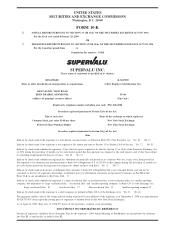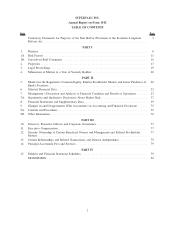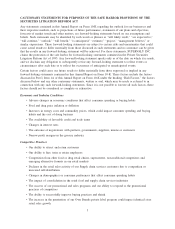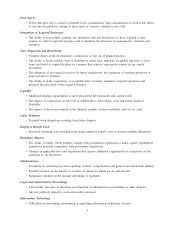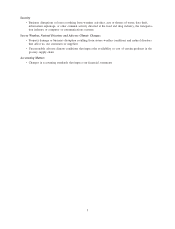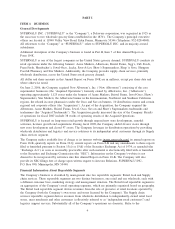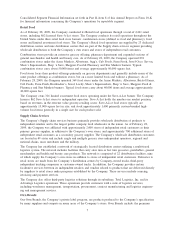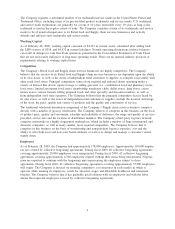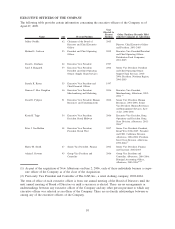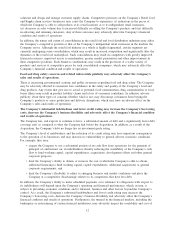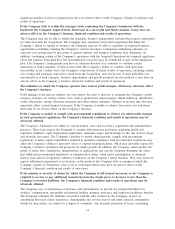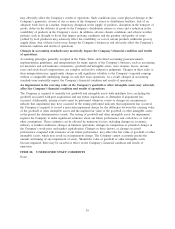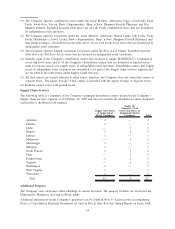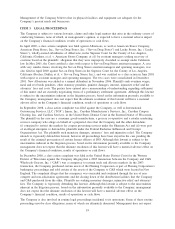Albertsons 2009 Annual Report Download - page 15
Download and view the complete annual report
Please find page 15 of the 2009 Albertsons annual report below. You can navigate through the pages in the report by either clicking on the pages listed below, or by using the keyword search tool below to find specific information within the annual report.Each of the executive officers of the Company has been in the employ of the Company or its subsidiaries for
more than five consecutive years, except for Duncan C. Mac Naughton, Kevin H. Tripp, Peter J. Van Helden
and Adrian J. Downes.
ITEM 1A. RISK FACTORS
Various risks and uncertainties may affect the Company’s business. Any of the risks described below or
elsewhere in this Annual Report on Form 10-K or the Company’s other SEC filings may have a material
impact on the Company’s business, financial condition or results of operations.
General economic conditions, which are largely out of the Company’s control, may adversely affect the
Company’s financial condition and results of operations.
The Company’s Retail food and Supply chain services businesses are sensitive to changes in general economic
conditions, both nationally and locally. Recessionary economic cycles, higher interest rates, higher fuel and
other energy costs, inflation, increases in commodity prices, higher levels of unemployment, higher consumer
debt levels, higher tax rates and other changes in tax laws or other economic factors that may affect consumer
spending or buying habits may adversely affect the demand for products the Company sells in its stores or
distributes to its independent retail customers. The United States economy and financial markets have declined
and experienced volatility due to uncertainties related to energy prices, availability of credit, difficulties in the
banking and financial services sectors, the decline in the housing market, diminished market liquidity, falling
consumer confidence and rising unemployment rates. As a result, consumers are more cautious. This may lead
to additional reductions in consumer spending, to consumers trading down to a less expensive mix of products
or to consumers trading down to discounters for grocery items, all of which may affect the Company’s
financial condition and results of operations. We are unable to predict when the economy will improve. If the
economy does not improve, the Company’s business, results of operations and financial condition may be
adversely affected.
Furthermore, the Company may experience additional reductions in traffic in its own stores or stores of
independent retail customers that it supplies, or limitations on the prices the Company can charge for its
products, either of which could may the Company’s sales and profit margins and have a material adverse
affect on the Company’s financial condition and results of operations. Also, economic factors such as those
listed above and increased transportation costs, inflation, higher costs of labor, insurance and healthcare, and
changes in other laws and regulations may increase the Company’s cost of sales and the Company’s operating,
selling, general and administrative expenses, and otherwise adversely affect the financial condition and results
of operations of the Company’s Retail food and Supply chain services businesses.
The Company faces a high level of competition in the Retail food and Supply chain services businesses,
which may adversely affect the Company’s financial condition and results of operations.
The Company’s Retail food business faces competition for customers, employees, store sites, products and in
other important areas from traditional grocery retailers, including regional and national chains and independent
food store operators, and non-traditional retailers, such as supercenters, membership warehouse clubs,
combination food and pharmacy stores, limited assortment food stores, specialty supermarkets, drug stores,
discount stores, dollar stores, convenience stores and restaurants. The Company’s ability to attract customers in
this business is dependent, in large part, upon a combination of product price, quality, assortment, brand
recognition, store location, in-store marketing and design, promotional strategies and continued growth into
new markets. In addition, the nature and extent to which our competitors implement various pricing and
promotional activities in response to increasing competition and the Company’s response to these competitive
actions, can adversely affect profitability.
The Company’s Supply chain services business is primarily wholesale distribution and includes a third-party
logistics component. The distribution component of the Company’s Supply chain services business competes
with traditional grocery wholesalers on the basis of product price, quality, assortment, schedule and reliability
of deliveries, service fees and distribution facility locations. The third-party logistics component of the
Company’s Supply chain services business competes nationwide in a highly fragmented marketplace with a
number of large international and domestic companies and many smaller, regional companies on the basis of
warehousing and transportation logistics expertise, cost and the ability to offer asset and non-asset based
11


